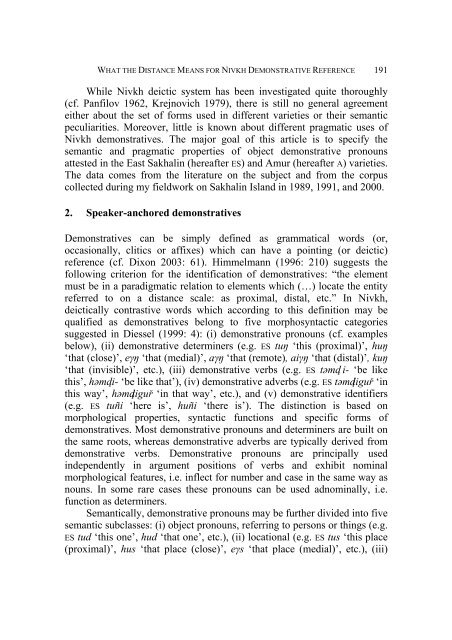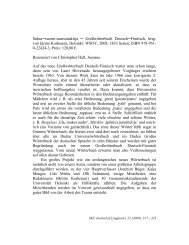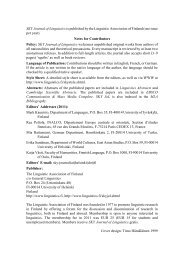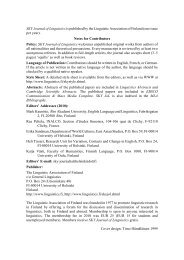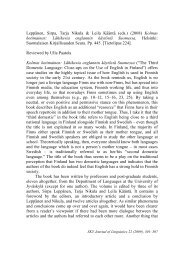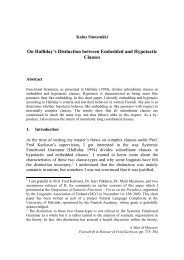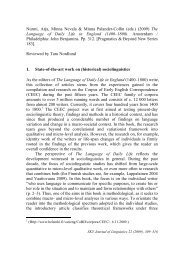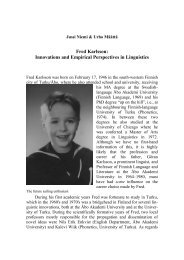'How Far from Origo?' or What the Distance Means for Nivkh ...
'How Far from Origo?' or What the Distance Means for Nivkh ...
'How Far from Origo?' or What the Distance Means for Nivkh ...
You also want an ePaper? Increase the reach of your titles
YUMPU automatically turns print PDFs into web optimized ePapers that Google loves.
WHAT THE DISTANCE MEANS FOR NIVKH DEMONSTRATIVE REFERENCE<br />
While <strong>Nivkh</strong> deictic system has been investigated quite th<strong>or</strong>oughly<br />
(cf. Panfilov 1962, Krejnovich 1979), <strong>the</strong>re is still no general agreement<br />
ei<strong>the</strong>r about <strong>the</strong> set of f<strong>or</strong>ms used in different varieties <strong>or</strong> <strong>the</strong>ir semantic<br />
peculiarities. M<strong>or</strong>eover, little is known about different pragmatic uses of<br />
<strong>Nivkh</strong> demonstratives. The maj<strong>or</strong> goal of this article is to specify <strong>the</strong><br />
semantic and pragmatic properties of object demonstrative pronouns<br />
attested in <strong>the</strong> East Sakhalin (hereafter ES) and Amur (hereafter A) varieties.<br />
The data comes <strong>from</strong> <strong>the</strong> literature on <strong>the</strong> subject and <strong>from</strong> <strong>the</strong> c<strong>or</strong>pus<br />
collected during my fieldw<strong>or</strong>k on Sakhalin Island in 1989, 1991, and 2000.<br />
2. Speaker-anch<strong>or</strong>ed demonstratives<br />
Demonstratives can be simply defined as grammatical w<strong>or</strong>ds (<strong>or</strong>,<br />
occasionally, clitics <strong>or</strong> affixes) which can have a pointing (<strong>or</strong> deictic)<br />
reference (cf. Dixon 2003: 61). Himmelmann (1996: 210) suggests <strong>the</strong><br />
following criterion f<strong>or</strong> <strong>the</strong> identification of demonstratives: “<strong>the</strong> element<br />
must be in a paradigmatic relation to elements which (…) locate <strong>the</strong> entity<br />
referred to on a distance scale: as proximal, distal, etc.” In <strong>Nivkh</strong>,<br />
deictically contrastive w<strong>or</strong>ds which acc<strong>or</strong>ding to this definition may be<br />
qualified as demonstratives belong to five m<strong>or</strong>phosyntactic categ<strong>or</strong>ies<br />
suggested in Diessel (1999: 4): (i) demonstrative pronouns (cf. examples<br />
below), (ii) demonstrative determiners (e.g. ES tuŋ ‘this (proximal)’, huŋ<br />
‘that (close)’, eγŋ ‘that (medial)’, aγŋ ‘that (remote), aiγŋ ‘that (distal)’, kuŋ<br />
‘that (invisible)’, etc.), (iii) demonstrative verbs (e.g. ES təmd i- ‘be like<br />
this’, həmd i- ‘be like that’), (iv) demonstrative adverbs (e.g. ES təmdiiguř ‘in<br />
this way’, həmdiiguř ‘in that way’, etc.), and (v) demonstrative identifiers<br />
(e.g. ES tuñi ‘here is’, huñi ‘<strong>the</strong>re is’). The distinction is based on<br />
m<strong>or</strong>phological properties, syntactic functions and specific f<strong>or</strong>ms of<br />
demonstratives. Most demonstrative pronouns and determiners are built on<br />
<strong>the</strong> same roots, whereas demonstrative adverbs are typically derived <strong>from</strong><br />
demonstrative verbs. Demonstrative pronouns are principally used<br />
independently in argument positions of verbs and exhibit nominal<br />
m<strong>or</strong>phological features, i.e. inflect f<strong>or</strong> number and case in <strong>the</strong> same way as<br />
nouns. In some rare cases <strong>the</strong>se pronouns can be used adnominally, i.e.<br />
function as determiners.<br />
Semantically, demonstrative pronouns may be fur<strong>the</strong>r divided into five<br />
semantic subclasses: (i) object pronouns, referring to persons <strong>or</strong> things (e.g.<br />
ES tud ‘this one’, hud ‘that one’, etc.), (ii) locational (e.g. ES tus ‘this place<br />
(proximal)’, hus ‘that place (close)’, eγs ‘that place (medial)’, etc.), (iii)<br />
191


